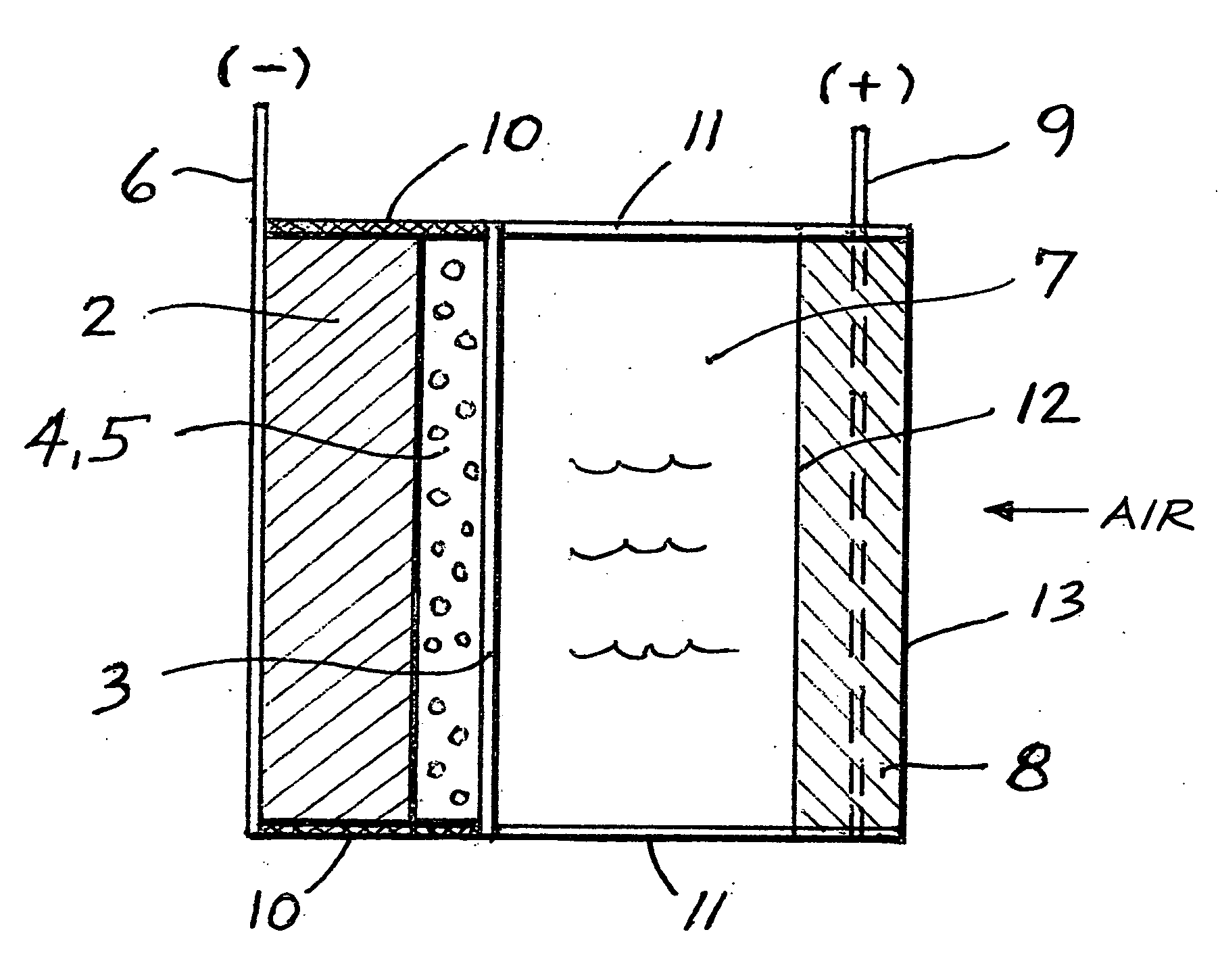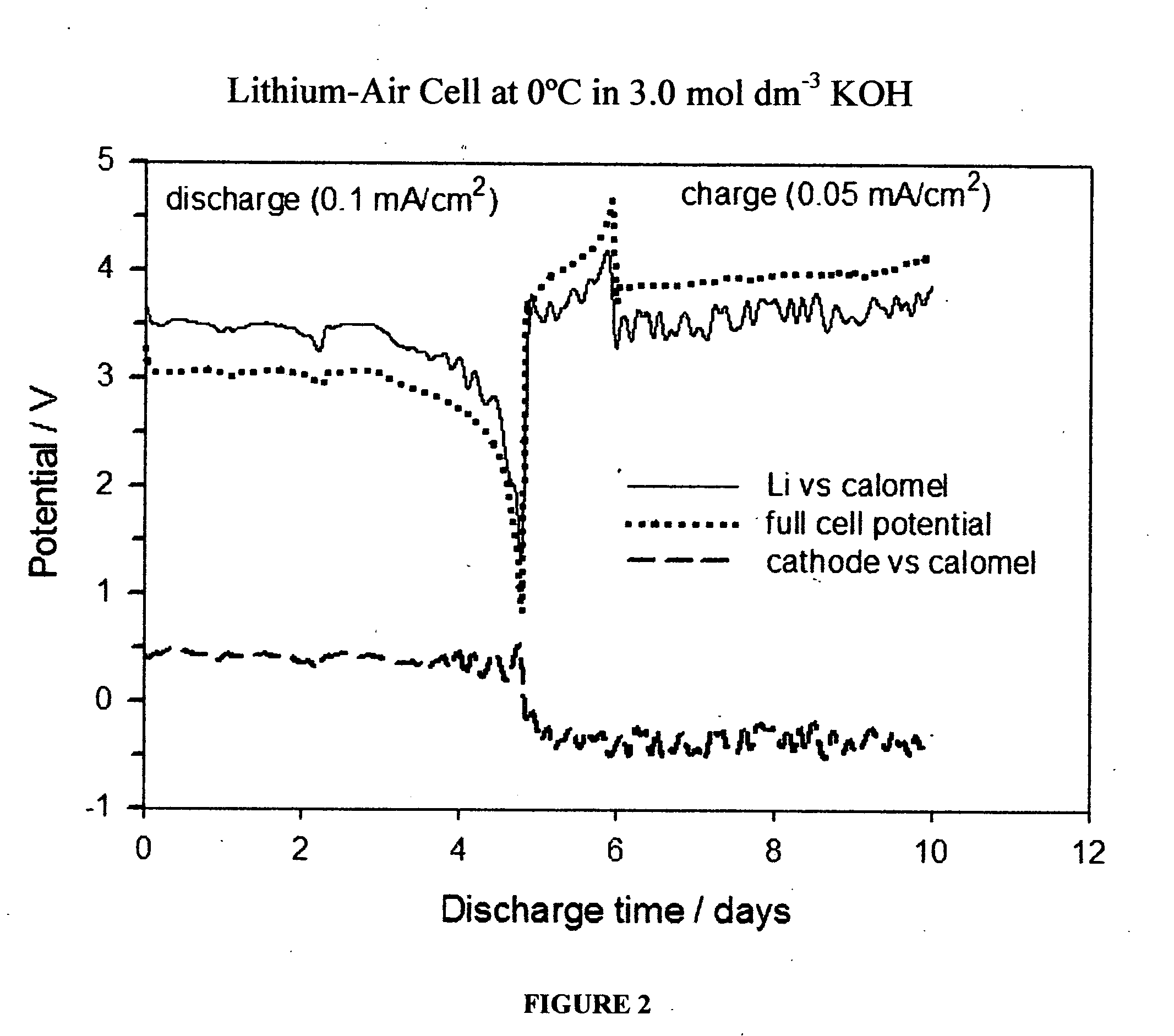Metal-air semi-fuel cell with an aqueous acid based cathode
a technology of lithium air and semi-fuel cells, which is applied in the field of lithium air semi-fuel cells, can solve the problems of significant reduction of the energy density capability of parasitic reactions, shutting down of the cell and battery, and introducing a major safety problem, so as to achieve long-term operation, high practical specific energy, and cell energy. high
- Summary
- Abstract
- Description
- Claims
- Application Information
AI Technical Summary
Benefits of technology
Problems solved by technology
Method used
Image
Examples
example # 1
EXAMPLE #1
[0033] A lithium-air cell (No. 1 corresponding to Mechanism 3) was prepared according to the schematic of FIG. 1, in which the first membrane in contact with lithium is a Celgard 2300 micro-porous inert membrane containing a lithium compatible lithium ion conductive electrolyte solution comprised of a 1 mol / dm3 LiPF6 in a 1:3 mixture (w / w) of EC:EMC (ethylene carbonate and ethylmethyl carbonate). The thickness of this first membrane in contact with metallic lithium is 25 μm. The outer membrane is Ohara's glass-ceramic LIC-GC material, which is 75 μm thick, and the edges of this composite anode are sealed with an epoxy (Epon 828 / 3234) to completely eliminate the ingress of water into the composite anode electrode. This composite anode was immersed in an aqueous H2SO4 solution containing 39.1 mass % H2SO4 which corresponds to a concentration of 5.26 mol dm3. The freezing point of this aqueous acid solution is −70° C., and its conductivities at 25° C. and −40° C. are around 1...
example # 2
EXAMPLE #2
[0034] A lithium-air cell (No. 2 corresponding to Mechanism 4) was prepared according to the schematic of FIG. 1 in which the first membrane in contact with lithium is a Celgard 2325 microporous inert membrane containing a lithium compatible, lithium ion conductive electrolyte solution comprised of a 1 mol / dm3 LiPF6 in a 1:3 mixture (w / w) of EC:EMC (ethylene carbonate and ethylmethyl carbonate). The thickness of this first membrane in contact with metallic lithium is 25 μm. The outer water stable membrane is Ohara's glass-ceramic LIC-GC material which is 75 μm thick, and the edges of this composite anode were sealed with an epoxy (Epon 828 / 3234) to completely eliminate the ingress of water into the composite anode electrode assembly. This composite anode was immersed in an aqueous KOH solution containing 15 mass % KOH which corresponds to a concentration of 3 mol dm3. The freezing point of this aqueous alkaline solution is −15° C., and its conductivity at 20° C. is around ...
example # 3
EXAMPLE #3
[0035] A lithium-air cell (No. 3) was prepared in an identical manner as the cell described in Example 1. However, as shown in FIG. 4, which is another embodiment of this invention, it was discharged at 0° C. at a constant current of 0.1 mA / cm2 until almost all of the lithium in the anode was depleted (again, a capacity of 5.3 mAh / g lithium was achieved). A reference electrode was not used in this study.
PUM
 Login to View More
Login to View More Abstract
Description
Claims
Application Information
 Login to View More
Login to View More - R&D
- Intellectual Property
- Life Sciences
- Materials
- Tech Scout
- Unparalleled Data Quality
- Higher Quality Content
- 60% Fewer Hallucinations
Browse by: Latest US Patents, China's latest patents, Technical Efficacy Thesaurus, Application Domain, Technology Topic, Popular Technical Reports.
© 2025 PatSnap. All rights reserved.Legal|Privacy policy|Modern Slavery Act Transparency Statement|Sitemap|About US| Contact US: help@patsnap.com



